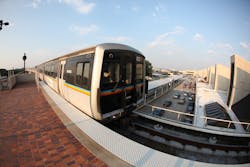Digitalization to Optimize Rail Operations
Railways in the United States are utilizing developing technologies within the digitization of their systems. The addition of technology offers increased efficiency, making it easier for agencies to operate at a higher level. Agencies across the country are incorporating a number of different types of technology within the system, including:
- Signaling
- The Internet of Things (IoT)
- Cyber security
- Predictive maintenance and asset management
- Passenger amenities
The Metropolitan Atlanta Rapid Transit Authority (MARTA) has implemented the use of technology to increase security systems on its routes, provide passenger information and alerts.
Signaling
With the Positive Train Control (PTC) deadline approaching, signaling is one of the prominent areas in which to digitalize a transit network.
“MARTA is one of the few properties in the U.S. which has been using automatic train control (ATC) since rail transit service began in 1979. This system exceeds the requirements of PTC,” said David Springstead, assistant general manager of Capital Programs & Development.
Springstead highlighted the key functions of MARTA’s PTC:
- Automatic Train Operations (ATO): Regulates train start/stop and speeds
- Automatic Line Supervision (ALS): Regulates dispatch, routes, and communication
- Automatic Train Protection (ATP): Enforces safe operation through speed control and train separation
Managing the system and its assets
To keep a network effectively digitalized, an agency needs to have a strong infrastructural support system. Facilities for operations, safety operators and maintenance connect the network and ensures that it runs efficiently.
“MARTA recently commissioned a new state-of-the-art Integrated Operations Center, Emergency Operation Center and is on the home stretch on a system wide Train Control and SCADA upgrade project,” said Springstead. “These projects not only leverage technology, but allow MARTA to change antiquated business processes to optimize service delivery, safety, security and emergency response capability.”
Enhanced mapping for everything from the addition of grid-lines to instant notifications and alerts on rail lines, is seeing more and more technologies into the market. Technology offers the easy of customization from agency to agency.
Digitalizing for a safer system
“As part of MARTA’s security profile, a Security Design Criteria and Security Certification Program helps to ensure that security technologies are part of any rail expansion, upgrade or lifecycle refresh. This includes finding dual purpose solutions for technologies that provide internal intelligence about system readiness and normalcy,” explained Major Aston Greene, commander, Emergency Preparedness Unit, MARTA Police. “For example, new cybersecurity protocols for SCADA systems are currently being deployed, which improve efficiencies, but also addresses the mitigation of cyber-related threats to transit systems.”
Technology, such as CCTV and cameras, has increased how MARTA is able to get images of suspects to the police. Greene explained that this has resulted in MARTA Police’s 95-percent solvability rate of Part I crimes. “…suspects are quickly identified and apprehended. Given this tactical use of technology, MARTA Police is able to quickly address crimes and minimize both threats and delays to our transit service.”
MARTA deploys cameras, as well as direct lines for passengers to report suspicious activities while riding.
“MARTA has a robust vehicle security camera system that features video and audio on all rail cars in addition to having fixed CCTV Cameras at all rail stations. Additionally, MARTA deploys a SEE&SAY App for all patrons to utilize while on the rail system that is monitored at a Police Communications Center. This app enables passengers to send discreet messages via smartphones that can lead to immediate police responses on the rail system,” said Greene. “Additionally, technologies supporting the rail system include the implementation of video analytic solutions at key stations which turns cameras into ‘smart-cameras’ that can alert on suspicious activity and a new Emergency Operations Center dedicated to supporting any emergencies that may occur on the rail system.”
Passenger amenities
In a changing transportation landscape—that’s incorporating autonomous vehicles, car sharing services, as well as bicycle and scooter sharing—passenger signage and amenities add benefits and increase ridership.
“MARTA is in the process of deploying enhanced cellular and Wi-Fi connectivity for patrons at the stations and in the rail cars that will allow for passengers to call and connect seamlessly throughout the rail line for improved safety,” said Kirk Talbott, AGM Technology/CIO.
